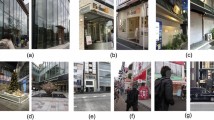Abstract
Given a cell phone image of a building we address the problem of place-of-interest recognition in urban scenarios. Here, we go beyond what has been shown in earlier approaches by exploiting the nowadays often available 3D building information (e.g. from extruded floor plans) and massive street-level image data for database creation. Exploiting vanishing points in query images and thus fully removing 3D rotation from the recognition problem allows then to simplify the feature invariance to a purely homothetic problem, which we show enables more discriminative power in feature descriptors than classical SIFT. We rerank visual word based document queries using a fast stratified homothetic verification that in most cases boosts the correct document to top positions if it was in the short list. Since we exploit 3D building information, the approach finally outputs the camera pose in real world coordinates ready for augmenting the cell phone image with virtual 3D information. The whole system is demonstrated to outperform traditional approaches on city scale experiments for different sources of street-level image data and a challenging set of cell phone images.
Similar content being viewed by others
References
Baatz, G., Köser, K., Chen, D., Grzeszczuk, R., & Pollefeys, M. (2010). Handling urban location recognition as a 2D homothetic problem. In ECCV.
Bay, H., Ess, A., Tuytelaars, T., & Van Gool, L. (2008). SURF: Speeded Up Robust Features. Computer Vision and Image Understanding, 110(3).
Bishop, C. M. (2006). Pattern recognition and machine learning. ISBN 0-387-31073-8, Section 2.5.1, p. 123.
Cao, Y., & McDonald, J. (2009). Viewpoint invariant features from single images using 3D geometry. In IEEE Workshop on Applications of Computer Vision.
Chandrasekhar, V., Takacs, G., Chen, D., Tsai, S., Grzeszczuk, R., & Girod, B. (2009). CHoG: compressed histogram of gradients. In CVPR.
Dreuw, P., Steingrube, P., Hanselmann, H., & Ney, H. (2009). SURF-face: face recognition under viewpoint consistency constraints. In BMVC.
Duda, R. O., & Hart, P. E. (1972). Use of the hough transformation to detect lines and curves in pictures. Communications of the ACM, 15(1), 11–15.
Irschara, A., Zach, C., Frahm, J.-M., & Bischof, H. (2009). From structure-from-motion point clouds to fast location recognition. In CVPR.
Jegou, H., Douze, M., & Schmid, C. (2008). Hamming embedding and weak geometric consistency for large scale image search. In ECCV.
Knopp, J., Sivic, J., & Pajdla, T. (2010). Avoiding confusing features in place recognition. In ECCV.
Kosecka, J., & Zhang, Wei (2002). Video compass. In ECCV.
Köser, K., & Koch, R. (2007). Perspectively invariant normal features. In Workshop on 3D Representation for Recognition, ICCV.
Lowe, D. G. (2004). Distinctive image features from scale-invariant keypoints. International Journal of Computer Vision, 60(2), 91–110.
Mikolajczyk, K., & Schmid, C. (2005). A performance evaluation of local descriptors. IEEE Transactions on Pattern Analysis and Machine Intelligence, 27(10), 1615–1630.
Nistér, D., & Stewénius, H. (2006). Scalable recognition with a vocabulary tree. In CVPR.
Perdoch, M., Chum, O., & Matas, J. (2009). Efficient representation of local geometry for large scale object retrieval. In CVPR.
Philbin, J., Chum, O., Isard, M., Sivic, J., & Zisserman, A. (2007). Object retrieval with large vocabularies and fast spatial matching. In CVPR.
Robertson, D., & Cipolla, R. (2004). An image based system for urban navigation. In BMVC.
Schindler, G., Brown, M., & Szeliski, R. (2007). City-scale location recognition. In CVPR.
Schindler, G., Krishnamurthy, P., Lublinerman, R., Liu, Y., & Dellaert, F. (2008). Detecting and matching repeated patterns for automatic geo-tagging in urban environments. In CVPR.
Sivic, J., & Zisserman, A. (2003). Video Google: a text retrieval approach to object matching in videos. In ICCV.
Takacs, G., Chandrasekhar, V., Tsai, S., Chen, D., Grzeszczuk, R., & Girod, B. (2010). Unified real-time tracking and recognition with rotation-invariant fast features. In CVPR.
Wu, C., Clipp, B., Li, X., Frahm, J.-M., & Pollefeys, M. (2008a). 3D model matching with viewpoint invariant patches (VIPs). In CVPR.
Wu, C., Fraundorfer, F., Frahm, J., & Pollefeys, M. (2008b). 3D model search and pose estimation from single images using VIP features. In Workshop on Search in 3D, CVPR.
Zamir, A., & Shah, M. (2010). Accurate image localization based on Google maps street view. In ECCV.
Zhang, W., & Kosecka, J. (2006). Image based localization in urban environments. In 3DPVT.
Zhu, Z., Oskiper, T., Samarasekera, S., Kumar, R., & Sawhney, H. S. (2008). Real-time global localization with a pre-built visual landmark database. In CVPR.
Author information
Authors and Affiliations
Corresponding author
Rights and permissions
About this article
Cite this article
Baatz, G., Köser, K., Chen, D. et al. Leveraging 3D City Models for Rotation Invariant Place-of-Interest Recognition. Int J Comput Vis 96, 315–334 (2012). https://doi.org/10.1007/s11263-011-0458-7
Received:
Accepted:
Published:
Issue Date:
DOI: https://doi.org/10.1007/s11263-011-0458-7




